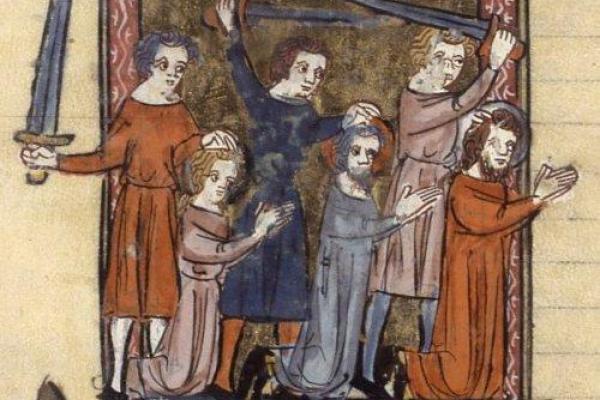Editor's Note: St. Crescentia of Lucania's feast day is celebrated on May 16 in the Eastern Orthodox Church.
Hers is a hidden and uncertain story, but it is said that the martyr St. Crescentia of Lucania was part of “the help” in a Roman senator’s household. She is one of a trio of holy martyrs that also includes St. Vitus and St. Modestus, all originally from Sicily. She might not even have been real, if we’re to trust modern, historical standards.
We are told that all three gave their last living witness for Christ, marching fearlessly into death, under persecution from Emperor Diocletian in 303 C.E. They died in the town of Lucania, a region in southwestern Italy where they enjoyed a lively posthumous cult following for centuries. But in the midst of its 1969 calendar reforms under Vatican II, the Roman Catholic Church finally decided to boot the trio from the general saints calendar on the grounds that they may have been only folklore.
There’s reason to suspect it. Though much adored, the stories told of the three are slippery. But the story goes that Crescentia worked as a nanny in a Roman senator’s house, minding and teaching young Vitus, his son. She was married to Modestus, who worked as Vitus’s tutor. Crescentia and Modestus apparently played a key role in Vitus’s conversion to Jesus, offering him spiritual guidance, kinship, and formation. But when Hylas, the senator-patriarch, learned that his son had become a Christ-worshiper, he took severe measures in hope he would recant, including torture. Still, Vitus remained resolute in the faith.
Seeing their young charge suffer, Modestus and Crescentia spirited him away to a river’s edge where they escaped on a boat (escorted by an accompanying angel). Making the most of his deliverance, young Vitus engaged in a lively ministry of healing and evangelism, and, at some point, even performed an exorcism for the emperor’s son.
The tale now becomes hazier. All three may have been tortured to death at this point because the emperor did not approve of Vitus’s spiritual meddling in his own household. Some accounts say that they weren’t quite tortured to death but, gravely wounded, were carried by (another) angel to Lucania, where they then died. In another account the emperor only locks up and tortures Vitus and Modestus, leaving the nanny alone.
But, in some accounts, Crescentia publicly confronts the emperor for his cruelty against them and confesses Christ as well. She then is also tortured to death. An earthquake may (or may not) have happened at this point, brought on by Vitus’s prayers, which caused buildings to collapse, claimed civilian lives, and struck fear into Diocletian’s heart.
Even the art that honors this holy three feels a little contradictory. They're usually depicted dying for the faith in a pot of boiling oil, but in other works, they're about to be beheaded. Some accounts mention the rack.
And yet, as persecution and martyrdom tales go, the broad brush strokes paint a familiar picture, a story that could easily be told today. Having lived in cultures where conversion to Christianity is illegal and where household staff may have far more personal interaction with the young of elite parents, it’s easy for me to imagine real faces to these historically obscured lives.
Even now, in many parts of the world, conversion to Christ ushers in private persecutions and public earthquakes that threaten political structures and family honor. Those of us in the highly individualized, liberal West can barely comprehend the real threat and profound shame that Vitus’s faith represented to the Roman political and civic order and the household of one its senators. The help that Crescentia and Modestus offered to Vitus was treasonous both to household and to empire.
These three represented an earthquake that threatened to bring the neat order of life crashing down. In their story the family cult is laid bare for what it is, and a new, truer family forms in their flight for safety. The trio forms a holy image of how God uses the weak of the world — including the lowly, very often utterly hidden household help — to shame the wise. Who, in the end, really cared for Vitus and his well-being? Who truly loved him?
It’s also not surprising that Crescentia’s story has a gossamer, fantastical quality to it. It’s so familiar that it very well may have happened a thousand times over in history, in ten thousand places: a youngster quietly learning the good news from his nanny, who tenderly cares for and instructs him or her, day in and day out. That’s the shape of discipleship, and Vitus’s path reminds us that Christ will have his Church, often through the most unexpected, and also utterly ordinary ways.
Crescentia’s story may have been passed among the rest of the staff, told beneath billowing laundry lines under the Mediterranean sun or whispered while window-washing, making its way beyond the villa’s walls and out onto high roads and byways, where it was retold, augmented, amended, merging with other exaggerated, hopeful, wild, dream-like stories.
“Did you hear? She emerged from the crowd to confront the emperor!”
Or it wasn’t a dream at all, ever. But these days we’re not apt to lend it much credence because, after all, Crescentia was only part of “the help.” We still tend to think that they mess with the facts. They’re not usually the ones writing history, but let us be assured, they are there — making it.
Got something to say about what you're reading? We value your feedback!

